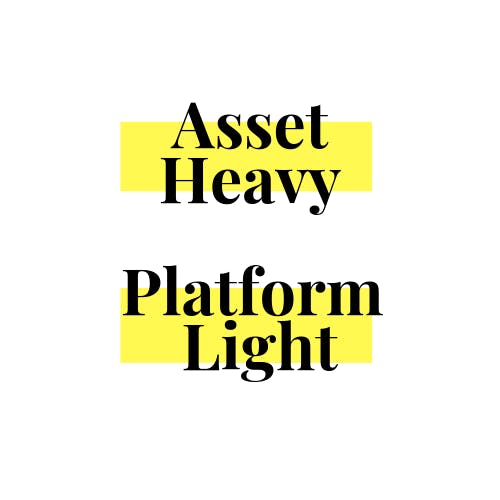It is not erratic to say that we have witnessed one of the major value destructing events in recent history with WeWork IPO fall out. The decimated value, in this case, an estimated $35 Billion is comparable to the value lost in the Enron scandal.
The we-work story is a cautious reminder that — irrational exuberance will be punished brutally and you will not see it coming in both public and private markets.
WeWork’s failure is not an indication that every other tech unicorn is overvalued. There are exciting companies like Stripe & Airbnb which will get their money’s worth in due course.
At the height of the negative press around WeWork, I wrote about the product-market fit and the positive aspects of the we-work as a business here.
The more interesting question that comes now is, what is a better business model for co-working space startups?
Firstly, here is the current business model of WeWork.
 Current Business Model — Asset Heavy Platform Light
Current Business Model — Asset Heavy Platform Light
Asset Heavy Platform Light (Current Business Model)
What WeWork and most co-working space startups have adopted can be called “Asset Heavy Platform Light”.
In this model, the company leases real estate long term and rents it out for the short term. The model is essentially an arbitrage opportunity and is hardly new.
The main risk in this model is the long term lease obligations with the supply side.
Whenever there is a slow down in the economy and there is no demand from the renters, the company has to essentially keep paying lease obligations with no revenue coming in. This is the fundamental problem that no public or private investor could address how we work is positioned to overcome.
WeWork’s implementation of this model has another unique problem. They have a skewed selection of demand with startups being ~50% of the customer base, who are first in the line to take a hit when a slow down happens.
This model also lacks another major key aspect, it is not a platform.
There is a nuance of what platform means here, it is not an internet marketplace that is bringing in producers and consumers together and facilitating more and efficient transactions that would have otherwise not been possible. But it could be a platform as we will see below.
There is a better version of a co-working space model — Asset Light Platform Heavy
 New Business Model — Asset Light Platform Heavy
New Business Model — Asset Light Platform Heavy
Asset Light Platform Heavy (New Business Model)
In a new model, co-working companies will need to go Asset Light. Meaning instead of leasing spaces from the real estate owners, they need to just focus on being a platform for workspaces connecting producers (real estate owners) and consumers (those who need workspaces to rent).
The new model should be singularly focused on creating tools and services to ease and increase existing and new transaction types for workspace needs. It should be more about orchestrating the workspace platform and less about leasing spaces from owners for the long term.
The platform should be about encouraging and enabling small real estate players to get access to scaled demand and quality they lack currently.
The new model will eliminate the ultimate deal maker of a company like WeWork — the long term lease obligations.
It should be a combination of what Airbnb does with home space in the U.S and what Oyo (an Indian Startup which acquired Hooters Las Vegas) does with Hotel space in India.
By truly being a workspace platform this model enables venturing into providing access to new workspaces. Where there will be new types of producers(supply side) and consumers(demand side) who are yet to be served.
Some examples would be —
B Bring existing podcasting studios online on to the platform. This will give consumers looking to start podcasts access to a great studio for a couple of hours a week.
2 Bring in existing music recording studios on to the platform and democratize access of start of the art equipment to ambitious upcoming artists with limited or no access to capital.
3 Bring in new real estate providers who are willing to provide could kitchens and give them to consumers who want to create a food delivery business without opening a restaurant.
4 Bring in Editing Studios to the platform and give the aspiring editor a chance to develop skills using state of the art equipment.
The new model gives a long run-rate for co-working space startups to create a sustainable long term business. It has all the advantages of a usual marketplace while avoiding the overhang of lease obligations. The risk is now distributed to the real estate owners and not centralized to the co-working space company.
Future
There is an opportunity with flexible workspace solutions like we-work (check this out). The model has a flaw and needs to be corrected and innovated with the new trends in individual sovereign careers. Both Oyo and Airbnb have the right experience and synergies to explore the new business model, and I predict they will enter this business in the next two years.
P — Prediction Alert! Airbnb will enter the co-working space business. Because what is an ideal co-working space company look like? It looks like an Airbnb which has workspaces listed on it.
You can find more about my views on WeWork here on my podcast End2End.
👏 If you liked this story, I’d appreciate your claps!
😃 Let’s connect on Twitter! *@natarajsindam*
👇 You can find more related stories from me below. WeWork Is Not WeWTF Is it all that bad?productcoalition.com Psychological Reason Behind The Success Of Freemium Model Why is Freemium as Persuasive as it is?productcoalition.com The $1 Trillion Secret Apple is not product story. It is something else.productcoalition.com

